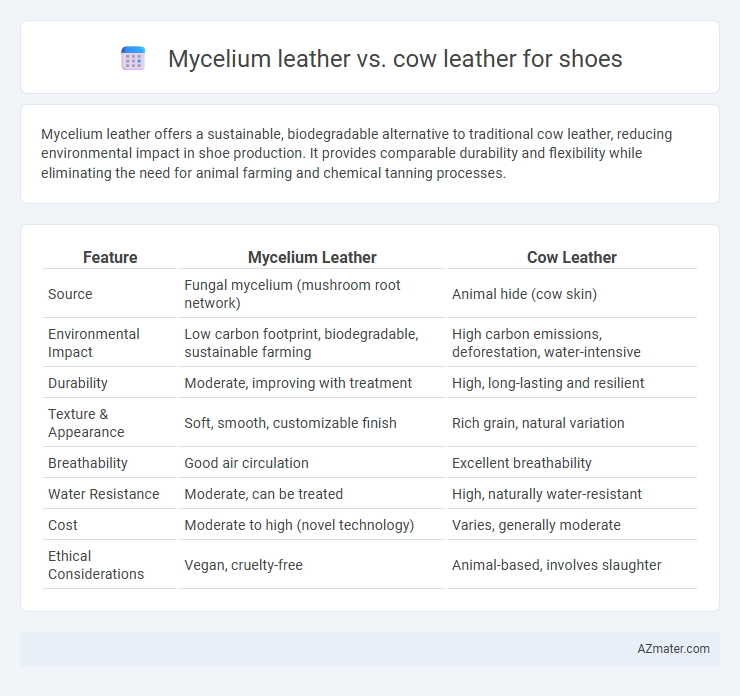Mycelium leather offers a sustainable, biodegradable alternative to traditional cow leather, reducing environmental impact in shoe production. It provides comparable durability and flexibility while eliminating the need for animal farming and chemical tanning processes.
Table of Comparison
| Feature | Mycelium Leather | Cow Leather |
|---|---|---|
| Source | Fungal mycelium (mushroom root network) | Animal hide (cow skin) |
| Environmental Impact | Low carbon footprint, biodegradable, sustainable farming | High carbon emissions, deforestation, water-intensive |
| Durability | Moderate, improving with treatment | High, long-lasting and resilient |
| Texture & Appearance | Soft, smooth, customizable finish | Rich grain, natural variation |
| Breathability | Good air circulation | Excellent breathability |
| Water Resistance | Moderate, can be treated | High, naturally water-resistant |
| Cost | Moderate to high (novel technology) | Varies, generally moderate |
| Ethical Considerations | Vegan, cruelty-free | Animal-based, involves slaughter |
Introduction to Mycelium and Cow Leather
Mycelium leather is a sustainable alternative made from mushroom root fibers that offers biodegradability and a lower environmental footprint compared to traditional cow leather. Cow leather, derived from cattle hides, is known for its durability, strength, and classic aesthetic, but involves resource-intensive farming and processing methods. Innovations in mycelium leather production aim to replicate the texture and resilience of cow leather while reducing carbon emissions and chemical use.
Environmental Impact Comparison
Mycelium leather production generates significantly lower greenhouse gas emissions and requires less water compared to traditional cow leather, reducing its overall environmental footprint. Unlike cow leather, which involves resource-intensive livestock farming and chemical tanning processes, mycelium leather is derived from fast-growing fungi and processed with minimal chemical input, minimizing pollution and deforestation. The biodegradable nature of mycelium leather further supports sustainability by decreasing landfill waste, contrasting with the slow decomposition and higher environmental costs associated with cow leather disposal.
Material Sourcing and Sustainability
Mycelium leather is derived from the root structure of fungi, offering a renewable and biodegradable alternative to traditional cow leather, which relies on resource-intensive cattle farming associated with high greenhouse gas emissions and deforestation. The production of mycelium leather consumes significantly less water and land, with a carbon footprint up to 90% lower than cow leather, promoting eco-friendly sourcing and circular economy principles in the footwear industry. Choosing mycelium leather shoes supports sustainable material innovation while reducing reliance on animal agriculture and its environmental impacts.
Production Processes Explained
Mycelium leather is produced by cultivating mushroom root structures in controlled environments, where fungal biomass is grown on agricultural waste, then processed and tanned without harmful chemicals, resulting in a sustainable alternative to traditional leather. Cow leather production involves raising livestock, followed by slaughtering, tanning with chromium salts or vegetable tannins, and extensive water and chemical use, which contributes to significant environmental impact. The mycelium leather process reduces greenhouse gas emissions and resource consumption compared to the high water usage and pollution associated with cow leather manufacturing for shoes.
Physical Properties and Durability
Mycelium leather offers superior tensile strength and flexibility compared to cow leather, making it ideal for durable and comfortable shoes. Its natural breathability and resistance to water absorption enhance shoe longevity, while cow leather remains prone to cracking and requires extensive maintenance. The sustainable, fungal-based mycelium material is lightweight yet robust, outperforming traditional cow leather in abrasion resistance and environmental impact.
Comfort and Breathability
Mycelium leather offers superior breathability compared to cow leather due to its porous structure, which allows better air circulation and moisture management, enhancing overall foot comfort. Cow leather, while durable and traditional, tends to retain more heat and moisture, potentially causing discomfort during extended wear. The biobased nature of mycelium leather also contributes to a lighter, more flexible shoe, further improving comfort levels in footwear applications.
Aesthetic and Design Versatility
Mycelium leather offers unique aesthetic qualities with its natural, textured patterns that can be easily customized through dyeing and embossing, providing a modern and eco-friendly appeal for shoe design. Cow leather maintains a classic, durable surface with a smooth finish that supports traditional and high-end luxury shoe styles, prized for its natural grain and aging properties. Designers favor mycelium leather for innovative, sustainable fashion statements while cow leather is preferred for timeless elegance and versatility in various shoe silhouettes.
Cost and Market Availability
Mycelium leather offers a sustainable and cost-effective alternative to traditional cow leather, often priced lower due to its faster production cycle and renewable raw materials. Cow leather remains more widely available in the market, benefiting from established manufacturing processes and extensive supply chains. Despite higher costs, cow leather dominates the shoe industry due to its durability and consumer familiarity, while mycelium leather is gaining traction in niche markets focusing on eco-conscious footwear.
Ethical Considerations
Mycelium leather offers a sustainable and cruelty-free alternative to traditional cow leather, reducing reliance on animal farming, which is a major contributor to greenhouse gas emissions and deforestation. Unlike cow leather production, mycelium leather manufacturing uses significantly less water and generates minimal waste, aligning with ethical concerns around environmental conservation. Choosing mycelium leather for shoes supports animal welfare and promotes a lower-impact lifecycle, appealing to consumers prioritizing ethical and eco-friendly fashion.
Future Trends in Shoe Manufacturing
Mycelium leather, derived from fungal roots, offers a sustainable and biodegradable alternative to traditional cow leather, which involves resource-intensive animal farming. Emerging technologies in shoe manufacturing emphasize the scalability and eco-friendliness of mycelium leather, aligning with global demands for reduced carbon footprints and ethical materials. Manufacturers increasingly integrate mycelium-based materials in innovative designs, signaling a shift toward circular economy principles and advanced biofabrication in the footwear industry.

Infographic: Mycelium leather vs Cow leather for Shoe
 azmater.com
azmater.com